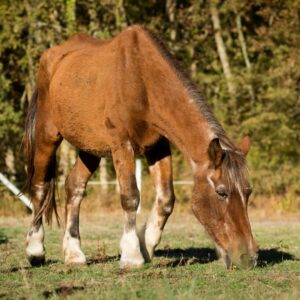 Selecting Forages for Horses Diagnosed with Equine Asthma: Environmental management is one of the most important aspects of treating and managing horses diagnosed with equine asthma. Asthma is a chronic condition that requires lifelong management changes to maintain respiratory function and overall health. Reducing exposure to respirable antigens, which are the inhaled molds, endotoxins, and other foreign matter that trigger immune response, can help alleviate the clinical symptoms of asthma. The most common respirable antigens in a horse’s environment come from hay, bedding, and potentially pasture.
Selecting Forages for Horses Diagnosed with Equine Asthma: Environmental management is one of the most important aspects of treating and managing horses diagnosed with equine asthma. Asthma is a chronic condition that requires lifelong management changes to maintain respiratory function and overall health. Reducing exposure to respirable antigens, which are the inhaled molds, endotoxins, and other foreign matter that trigger immune response, can help alleviate the clinical symptoms of asthma. The most common respirable antigens in a horse’s environment come from hay, bedding, and potentially pasture.
For horses diagnosed with barn-associated asthma, full-time pasture access is generally recommended. However, this is not an option for many horse owners, and hay is often the primary source of forage. Hay is a major concern for horses with asthma, as hay will always contain some respirable antigens. To reduce the amount of potential inhalation of dust and mold spores, several options are available to the horse owner.
Harm Reduction:
- Always ensure the hay is as clean as possible. Only use high-quality hay, as free as possible from dust and mold.
RDC:
- Research has shown that immersing, soaking, or steaming hay before feeding can significantly reduce the number of particles inhaled by the horse. Simply sprinkling the hay with water is inadequate. The hay must be completely immersed and wet throughout to reduce the respirable dust concentration (RDC). One research study found that immersing and thoroughly wetting hay more than halved the mean and maximum RDC in a horse’s breathing zone (the two-foot sphere around the horse’s nose). Other studies have evaluated soaked hay for asthmatic horses. They determined that 30-45 minutes of soaking is adequate to reduce RDC. Longer soaking provides no additional advantages. Horse owners must keep in mind that soaking hay reduces nutrient content. Steaming hay is effective at reducing respirable antigens with less potential for loss of nutrients. However, it is not a viable option for many horse owners. The choice of whether to immerse, soak, or steam hay may best be addressed by the options available to the owner and the horse’s symptoms. If immersing the hay is adequate to eliminate symptoms (usually coughing is the initial and recurring symptom), then that would be the simplest solution. Some research data indicate that feeding soaked hay or hay pellets helps improve lung function. The same study has not been performed using immersed hay.
- Remove any uneaten immersed, soaked, or steamed hay from the horse’s reach before it has a chance to generate mold.
Different Types of Asthma:
- For horses with severe asthma, entirely replace long-stemmed hay with pelleted hay or forage replacement, or a complete feed designed to provide adequate fiber to replace dietary forage. Particularly if clinical symptoms persist. Wetting pelleted hay will further reduce respirable particles and may allow the respiratory tract inflammation to subside. However, horses will consume pelleted forages more rapidly and with less chewing than long-stemmed forage. So the best practice would be to feed smaller quantities more often throughout the day.
- For horses diagnosed with pasture-associated asthma, the primary causes of respiratory inflammation are certain molds and pollens. They can be present in pastures during growing seasons, particularly during periods of high heat and humidity. Management in such situations includes removing affected horses from pasture during high-risk periods. Such horses usually do best when only allowed pasture access during the winter. During the periods that these horses are kept off pasture, some do require the same forage management as horses diagnosed with barn-associated asthma.
For all horses diagnosed with asthma, decreasing dust in the horse’s environment through ventilation, low-dust bedding, and careful attention to periods of high environmental dust (sweeping barn aisles, high wind, etc.), is recommended.
One additional suggestion for managing horses with equine asthma includes dietary supplementation to help control chronic inflammation. Marine-derived sources of omega-3 fatty acids have been shown to support immune response in horses, including mediation of inflammation.
Would you like more information about Selecting Forages for Horses Diagnosed with Equine Asthma? Contact us at J & J Farms by clicking here!
Article brought to you by KER.
